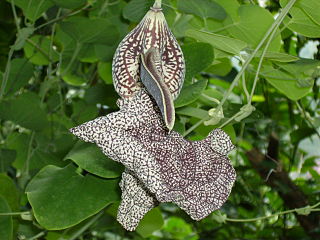
Aristolochia is a large plant genus with over 500 species that is the type genus of the family Aristolochiaceae. Its members are commonly known as birthwort, pipevine or Dutchman's pipe and are widespread and occur in the most diverse climates. Some species, like A. utriformis and A. westlandii, are threatened with extinction.

Birdwings are butterflies in the swallowtail family, that belong to the genera Trogonoptera, Troides, and Ornithoptera. Most recent authorities recognise 36 species, however, this is debated, and some authorities include additional genera. Birdwings are named for their exceptional size, angular wings, and birdlike flight. They are found across tropical Asia, mainland and archipelagic Southeast Asia, and Australasia.

Lansium parasiticum, commonly known as langsat, lanzones, or longkong in English; duku in Indonesian or dokong in Malay, is a species of tree in the Mahogany family with commercially cultivated edible fruits. The species is native to Southeast Asia.

Troides minos, the southern birdwing, is a large and striking swallowtail butterfly endemic to south India. With a wingspan of 140–190 mm, it is the second largest butterfly of India. It is listed as Least Concern in the IUCN Red List.

Pachliopta aristolochiae, the common rose, is a swallowtail butterfly belonging to the genus Pachliopta, the roses, or red-bodied swallowtails. It is a common butterfly which is extensively distributed across south and southeast Asia.

Rajah Brooke's birdwing is a birdwing butterfly from the rainforests of the Thai-Malay Peninsula, Borneo, Natuna, Sumatra, and various small islands west of Sumatra. The butterfly was named by the naturalist Alfred Russel Wallace in 1855, after James Brooke, the Rajah of Sarawak. The larval host plants are Aristolochia acuminata and A. foveolata. Adults sip flower nectar from plants such as Bauhinia. Rajah Brooke's birdwing is a protected species, listed under Appendix II of CITES, meaning that international export is restricted to those who have been granted a permit. It is the national butterfly of Malaysia.

Troides helena, the common birdwing, is a butterfly belonging to the family Papilionidae. It is often found in the wildlife trade due to its popularity with butterfly collectors. The butterfly has seventeen subspecies.
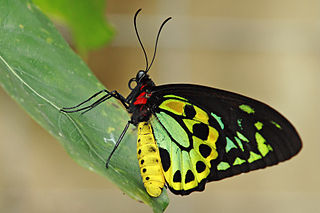
Ornithoptera euphorion, the Cairns birdwing, is a species of birdwing butterfly endemic to north-eastern Australia, and is Australia's largest endemic butterfly species. Other common names include Cooktown birdwing and northern birdwing. The names Cairns and Cooktown in its common name reference the Australian cities in the region where this butterfly is found.
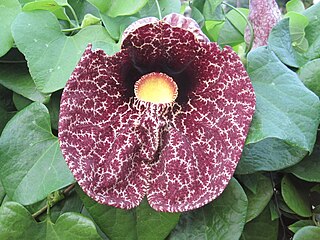
Aristolochia littoralis, the calico flower or elegant Dutchman's pipe, is a species of evergreen vine belonging to the family Aristolochiaceae.
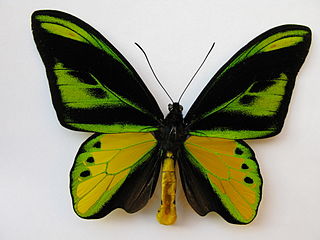
Ornithoptera chimaera, the chimaera birdwing, is a birdwing butterfly of the family Papilionidae. It is found in mountain areas of New Guinea, 1000 meters above sea level.
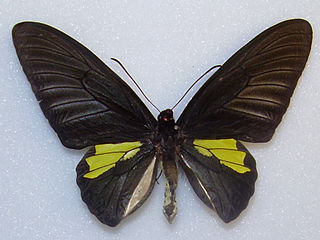
Troides plateni, the Dr. Platen's birdwing, is a birdwing butterfly endemic to Palawan, Balabac, Dumaran, and the Calamian Islands in the Philippines. It is named for Dr. Carl Constantin Platen.
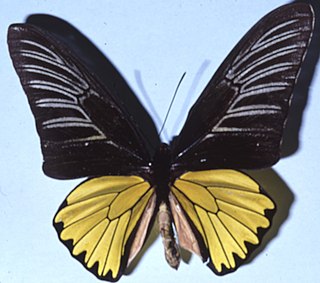
Troides magellanus, the Magellan birdwing, is a large and striking birdwing butterfly found in the Philippines and on Taiwan's Orchid Island.

Ornithoptera priamus, the common green birdwing, Cape York birdwing, Priam's birdwing, northern birdwing or New Guinea birdwing is a widespread species of birdwing butterfly found in the central and south Moluccas, New Guinea, Bismarck Archipelago, Solomon Islands, and north-east Australia.

Ornithoptera richmondia, the Richmond birdwing, is a species of birdwing butterfly that is endemic to Australia. It is the second smallest of the birdwing species, the smallest being Ornithoptera meridionalis.

Aristolochia westlandii is a species of plant in the family Aristolochiaceae. It is found in China and Hong Kong, in valley forests in Guangdong Province at an elevation of 300 to 800 metres. The leaves are long, narrow and pointed. The flowers are bent tubes from 10–15 centimetres (3.9–5.9 in) long that grow from the base of a leaf. They are yellow with purple veins and blotches.

Troides oblongomaculatus, the oblong-spotted birdwing, is a birdwing butterfly found in Indonesia and New Guinea.

Aristolochia indica is a creeper plant found in Southern India and also Sri Lanka. This plant is critical to the survival of the southern birdwing and common birdwing, as well as crimson and common rose butterflies. It reaches a height of several metres on trees and cover the branches with thick foliage. It is commonly found in forest floor, rocky hillslopes. It flowers once a year to produce seeds. It can also be propagated by roots. The plant has a number of historical medicinal uses.

Pararistolochia praevenosa is an Australian vine in the birthwort family. The Richmond birdwing butterfly vine grows in subtropical rainforest in coastal areas north from Wollongbar, in far north eastern New South Wales and adjacent areas in south eastern Queensland. It has been recorded as far north as the Mary River. It also grows in tropical north eastern Queensland, where it is a food plant for the Cairns birdwing butterfly.
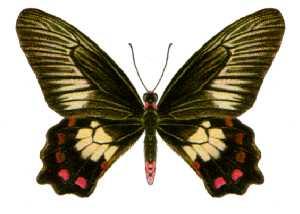
Pachliopta polydorus, the red-bodied swallowtail, is a butterfly from the family Papilionidae found in north-eastern Queensland, Australia as well as Papua New Guinea and New Zealand.

Aristolochia macrophylla, Dutchman's pipe or pipevine, is a vine native to the eastern United States. Aristolochia macrophylla belongs to the plant family Aristolochiaceae and is found primarily along the Cumberland Mountains and Blue Ridge Mountains in the eastern portion of the United States, as well as Ontario, Canada. This species of plant has received considerable attention in the past few decades for the discovery of a potent compound called aristolochic acid, which has been the focus of debate due its harmful side effects.




















